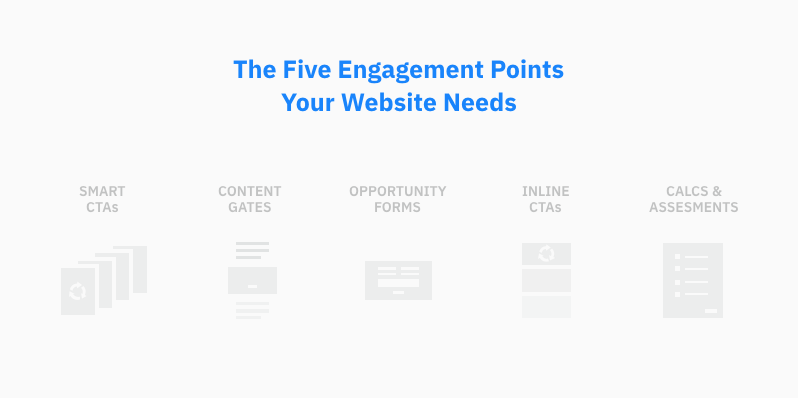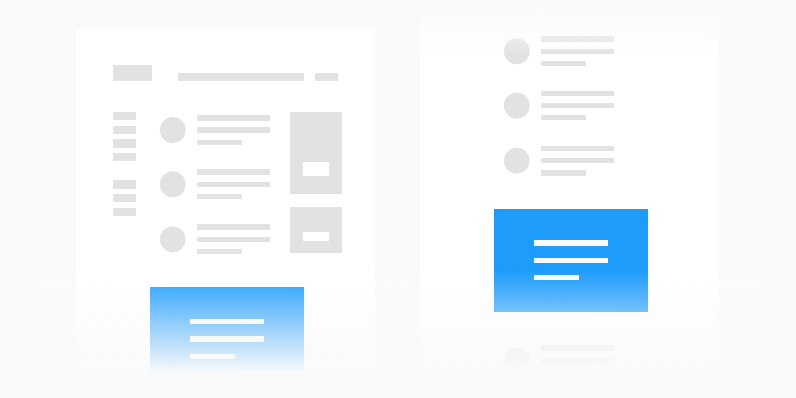Content is what attracts and informs prospects. And what provokes them to engage with you. But how they engage is entirely up to technology. Technology makes it possible to design effective progressive engagement.
There is no shortage of tools that can supply engagement technology for you — you should choose the one that best suits your needs — but few technology providers have a point of view on the types of forms and calls to action (CTAs) you should create, where to use them, and how to design them. In this article, I’d like to share my recommendations for how to engage prospects with the right calls to action and forms.
Five unique types of engagement points comprise the progressive engagement system your website uses to generate opportunity. They are:
- Smart CTAs — or sidebar widgets — which automatically cycle according to a prospect’s unique session history
- Content Gates, which require prospects to share information in order to gain access to content
- Opportunity Forms, which enable prospects to express direct interest in becoming customers
- Repeating Inline CTAs which automatically display as prospects scroll through your content archive
- Calculators and Assessments which enable prospects to directly analyze their own fit for your services.
Each of these five engagement points is designed to enable actions that make the most sense for prospects at each stage of the buying cycle.

The Prospect Buy Cycle
Researchers are looking for answers to questions, so engagement points that make them aware of content programs (like newsletter subscriptions) are the best way to earn fans that can become future clients.
Evaluators have decided to make a purchase, but have not yet decided which purchase to make. Forms that enable you to learn more about them in order to assess their fit (through recurring submissions like content gates) or enable them to self-assess (e.g. calculators) are the best types to engage and meet evaluator needs.
Buyers are ready to speak directly with you about working together. Forms that enable them to express their intent and tell you more about their need (e.g. “Let’s Talk”) are the best way to elevate opportunities that begin on your website.
Let’s go through each of the five engagement types and look specifically at how to use them to design effective progressive prospect engagement.
Smart CTAs
As I already described, “Smart” CTAs automatically cycle according to a prospect’s unique session history. They primarily exist in the sidebar of key content marketing pages on your website. Why in the sidebar? Great question. Hold on to it, because I wrote extensively about the role of sidebars in prospect user patterns in a previous article about designing your content hub. After you read this, head back to that article if you haven’t read it already.

There are three key attributes of a “Smart” CTA. They are:
- Clarity
Use verbs — words like “subscribe,” “download,” “request,” etc. — to make clear what action you expect a visitor to take and also help you to better affiliate engagement opportunities with the buying cycle. - Core Form Fields
Always require first name, last name, email and country fields on “Smart” CTA forms in order to keep your contacts database organized, automated programs personalized, and GDPR compliant. Also display this information after it has been collected to make clear to prospects that your website recognizes them personally. - Progressive Engagement
The goal of a “Smart” CTA system is to ensure that visitors are always shown the next best engagement opportunity for them. A “Smart” CTA will always display forms and content opportunities a prospect has not yet acted upon and require fields a prospect has not yet submitted. For example, if you’ve never filled out a form on this website, you should see two CTAs in the right sidebar of this page. The first is a newsletter subscription form and the second highlights a recent webinar. If you’ve already subscribed, you’ll see a recent webinar and a recent whitepaper. If you’ve already accessed that webinar, you’ll see a recent whitepaper and a short contact form. And so on.
Content Gates
A content gate is very simple. It requires prospects to share information in order to gain access to content. You may have heard this referred to as an “infowall.”

Effective content gates have three core attributes. They are:
- Clarity
Language and placement of this form should enable readers to recognize this form’s purpose and encourage them to make use of it in order to gain access to content in its full form. - Core Form Fields
Always require first name, last name, email and country fields on “Smart” CTA forms in order to keep your contacts database organized, automated programs personalized, and GDPR compliant. Also display this information after it has been collected to make clear to prospects that your website recognizes them personally. - Progressive Engagement
Like “Smart” CTAs, content gates should also require fields a prospect has not yet submitted.
Opportunity Forms
An opportunity form enables prospects to express direct interest in becoming customers. This is more than just a “contact form.” It should be designed to elevate the right prospects and focus their inquiries toward what you actually sell.

Effective opportunity forms have two core attributes. They are:
- Positioned to Filter
Instead of placing opportunity forms in sidebars, forms on positioning pages should be arranged according to the flow of the page’s content. Opportunity forms operate as filters, which means that reading the page’s content should be considered a prerequisite of completing the form. This is why positioning pages can follow single-column layouts with opportunity forms positioned without concern for above-the-fold visibility. - Consistent Display
Opportunity forms should display on positioning pages in a persistent manner, regardless of previous actions in a prospect’s session. While they should auto-fill known prospect data, they should have specific fields always required for submission, rather than defaulting to un-captured fields for progressive engagement.
Repeating Inline CTAs
Repeating inline CTAs automatically display as prospects scroll through your content archive. You might have 3-4 unique CTAs of this type that appear at a regular interval among your content archive, say every 4-5 posts in a list.

Effective inline CTAs have two core attributes. They are:
- Repetition
I recommend displaying inline CTAs within the content list on your content hub, repeating at an interval of every 3-5 articles. For example, if your archive contains 100 articles and 3 unique inline CTAs loading at an interval of every 3 articles, each one will repeat at least 10 times for a prospect who scrolls through every one. A prospect who scrolls through 30 articles will see these CTAs repeat at least twice. I wrote extensively on how this pattern helps prospects engaging in “vertical orientation” in my previous article on how to design your content hub. - Progressive Engagement
When a cycling CTA includes a form, the form should participate in progressive engagement. Like “Smart” CTAs, these forms should also require fields a prospect has not yet submitted. But not all cycling CTAs will have forms; most probably won’t. These recurring CTAs provide great opportunities to promote things that don’t always have an initial, trackable event (like a form submission) associated with them — things like books, events, podcasts, etc.
Calculators & Assessments
Calculators and assessments enable prospects to directly analyze their own fit for your services. These are the least common of the engagement points I regularly see on marketing websites because they are the most difficult to create. It’s not the technical complexity of setting up a form like this that makes them difficult, though. It’s the conceptual complexity that makes them challenging. Creating an effective calculator or assessment requires that you formulate a way of demonstrating — typically in a quantitative way — the value of your services.

Because quantifying your value proposition could take many forms, the most important consideration for these types of forms is the idea of persistent display. Calculators and assessments should display on pages in a persistent manner, regardless of previous actions in a prospect’s session. While they should auto-fill known prospect data, they should have specific fields always required for submission, rather than defaulting to un-captured fields for progressive engagement.
A Free Guide on How to Design Effective Progressive Engagement
To help you digest this information and take the right next strategic steps, whether that be in rethinking your prospect engagement tools altogether or just designing them to better fit these five applications, we’ve created a short guide you can download today. I hope it provides some needed direction!
This article is the tenth entry in a series that will guide you through applying the principles of Prospect Experience Design for yourself.
Next in the series is an introduction to creating a style guide for stock imagery that helps content creators.
